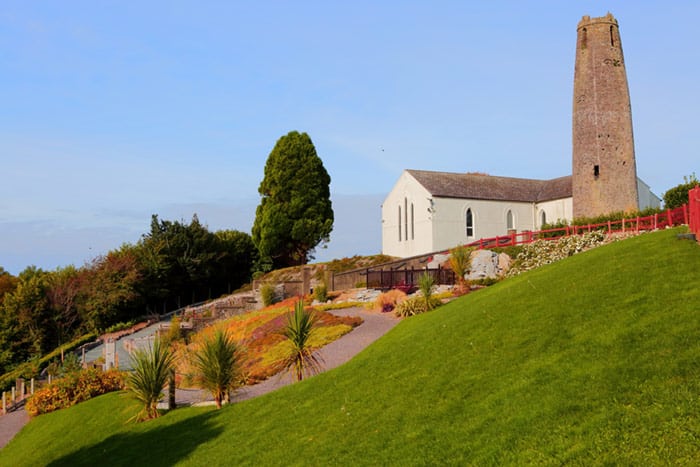Stop 13a. Waterloo
History

Waterloo: Water under the bridge
Waterloo is located 2.5km north of the famous village of Blarney.
It was named by an absentee landlord named George Putland to commemorate the 1815 battle of Waterloo. That year Putland’s bridge was built across the river Martin joining lands on both sides of the river previously only accessible by stepping stones. It was blown up during ‘The Troubles’ c.1921 and its marking stone was lost. It is commonly known as The Waterloo Bridge.
St Mary’s Church: Mass for the masses
In 1815 a site was granted free of charge by Mr Thomas Creamer to Rev John Lane for the construction of a parish church. Fr Matt Horgan designed and oversaw the building of the church. It was reported at the time that ‘upwards of 50 poor men from the parish and tradesmen from Cork are employed in the building of a handsome gothic church’. On completion in 1817, it was dedicated to St Mary. By 1835 the average Sunday mass attendance was 800.
By mid-1850’s St Mary’s was deemed to be too small for the growing population and was considerably extended and enlarged under the direction of Fr Alex Peyton, parish priest of Blarney from 1849 to 1858
St Mary’s remained the parish church until the Church of the Immaculate Conception was built in the village of Blarney in 1894.
Fr Matt Horgan: Ogham my God
Fr Matt Horgan was an antiquarian, scholar, prolific writer and a native Irish speaker. He discovered the key to the Ogham alphabet which enabled archaeologists to decipher the inscriptions on the ancient stones. He also happened to be the parish priest of Blarney!
In 1842 Fr Matt built a belfry (bell tower) standing to the east of St. Mary’s church in Waterloo. He saw the early bell towers which dot the Irish landscape, as a means of summoning early Christians to prayer, in addition to being places of storage and refuge. Fr Matt died in 1849 at the age of 46 and is buried in the transept of St. Marys Church.
Waterloo Tower: Ring out the bells!
During penal laws belfries on churches were prohibited. The granting of Catholic emancipation in 1829 saw an end to this.
The tower has a round-headed Romanesque style doorway in the west (280°) side, with orders decorated with spiral bosses, chevrons and stepped ornaments. Putlog holes are visible around the circumference at half height. Windows are both squared and pointed arch. The tower tapers to the top following a barrel shape curve.
The gardens south of the church are well worth a visit.
Waterloo School: To school through the fields!
(Ruins adjacent to the church in the Waterloo gardens)
The National Schools scheme was introduced in 1829 and the State gave grants to local communities to build schools and pay teachers. The foundation stone of Waterloo School was laid in 1835. The two storey building was situated on a somewhat hilly field adjacent to the Catholic Church. The location of the rural co-ed school was most likely influenced by the availability of religious ground. Today only the ruins are all that remain.
There were two classrooms both with wooden floors and an open fireplace. The only lavatory (the Waterloo loo!) was a detached, iron clad shed situated to the rear of the school.
Take Notice!
There are a number of information boards erected in Waterloo depicting the history and folklore of the area which visitors will find interesting.
The Waterloo Inn is a good spot for refreshment here. Then come back to Blarney and finish your tour.

